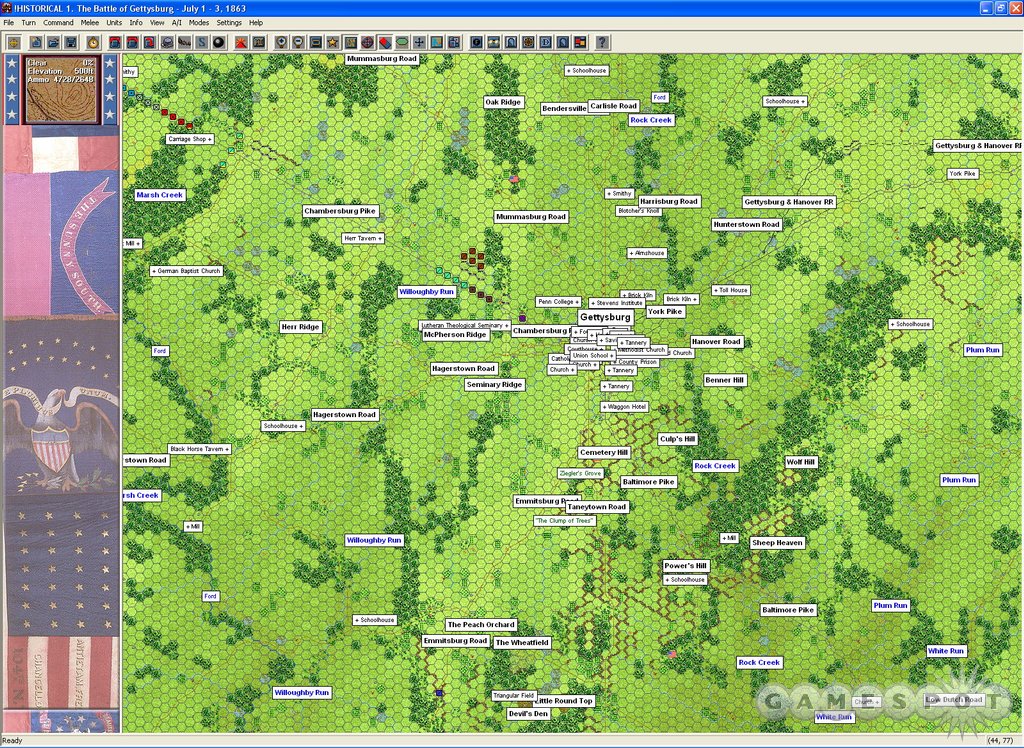Gettysburg is among the few battles in history that needs no introduction. If only the Rebs hadn't needed shoes, this decisive battle likely would have been fought elsewhere, and the South may have held on to its chance, however slender, of forcing the North out of the war. HPS Simulations' wargame Campaign Gettysburg covers not only the eponymous battle, but also the entire campaign leading up to it, using a combination of an elegant strategic layer and an excellent tactical combat system.

Most games in this genre welcome players with a campaign map, letting them shuffle units around, partake in politics, and see how the war is playing out on a grand scale. The campaign engine used here sticks to the combat, putting players in the boots of a general and giving them options that play out like a Choose Your Own Adventure book. For example, playing as Robert E. Lee, your cavalry may or may not obtain important reconnaissance information at Brandy Station during the opening stages of the complete Gettysburg campaign. If they don't you must blindly choose whether you want to risk surging north quickly (leaving your 3rd Corps trailing behind), or advance more slowly to consolidate your forces. If you meet the enemy as a result of your decision, a battle is fought using the tactical engine, and the outcome determines the menu of choices that will appear in the campaign interface.
If you are interested in the period but don't want to commit the time it takes to fight an entire campaign or even a single monster battle like Gettysburg, this package has you covered. The designer created more than 300 scenarios covering every aspect of the campaign, including historical and hypothetical engagements, and a complete scenario editor also is included for the "what if" junkies. You can learn the system playing a little four-turn scenario re-creating the opening shots of Gettysburg or the seven-turn fight for Little Round Top, and then take on larger and longer scenarios as you absorb the mechanics.
The gameplay is easy to grasp, and it does a good job of capturing the essence of combat during this period without burying players in minutiae. Infantry units do the bulk of the fighting and can deploy skirmishers to harass the enemy and probe for weaknesses. Cavalry units are used in their historical role as the "eyes" of the army and are terrific for harassing weakened infantry units or artillery units but are awful in direct combat with infantry. Artillery dominates the battlefields in which it is used, and learning how to advance in the face of withering cannon fire is one of the first skills players must develop.
As in the real war, you don't necessarily have to annihilate the enemy to win a battle. You just have to shake them up enough that they flee in disarray. This is modeled in the game by tracking unit fatigue, ammunition levels, and disruption, and it is vital to keep an eye on these stats so you know when a unit is about to break. Since routing is so common it also is important to keep a reserve in place whenever possible, and to put the best commanders in places where they will do the most good, since they can push their troops to fight harder and inspire disrupted units to rally. Players who can juggle all this while reading the terrain to find the best avenues of attack and the best perches for artillery will find that the game's turn-based combat system is very rewarding.
The graphical interface powering this game was used in several previous releases from HPS and is showing its age. Graphics for the strategic layer are crisp and legible, but amount to only still images and text. The tactical engine has colorful but plain maps, rudimentary 2D unit graphics, and blocky fixed-perspective 3D unit graphics that are not very appealing. Sound effects are limited to gunfire, and in fact everything is utilitarian, which is fine, considering the game's turn-based nature and accurate combat model.
The sheer scope of some of the battles included in this package demands that the graphics be clean and crisp instead of flashy, or players would soon lose track of everything. The monster 205-turn hypothetical Collision in Maryland scenario, for example, uses a map that is 242 hexes high by 436 hexes wide. It takes forever to scroll around this huge environment, and scrollbars on the side and bottom of the screen would be invaluable but unfortunately are not included. A jump map providing an overview of the entire battle is available, but it must be manually activated each time a user wants to quickly view another area of the map.
This sounds like heaven for Civil War buffs, but Campaign Gettysburg has an unfortunate Achilles' heel in an AI that simply doesn't know what to do with all the freedom this game affords. The computer puts up a decent fight in the smaller scenarios but falls flat on its face in the larger battles that play out over dozens or hundreds of turns. This isn't necessarily the fault of the designer, as no turn-based AI we've ever seen has been able to handle battles this massive--so if you want to enjoy the larger battles in this package, then finding a friend who wants to take you on is practically a requirement. Direct play, play-by-e-mail, and hotseat multiplayer modes are supported, so if you're a fan of the period and can find a willing foe, Campaign Gettysburg gives you everything you need to reenact one of the most epic campaigns of all time.